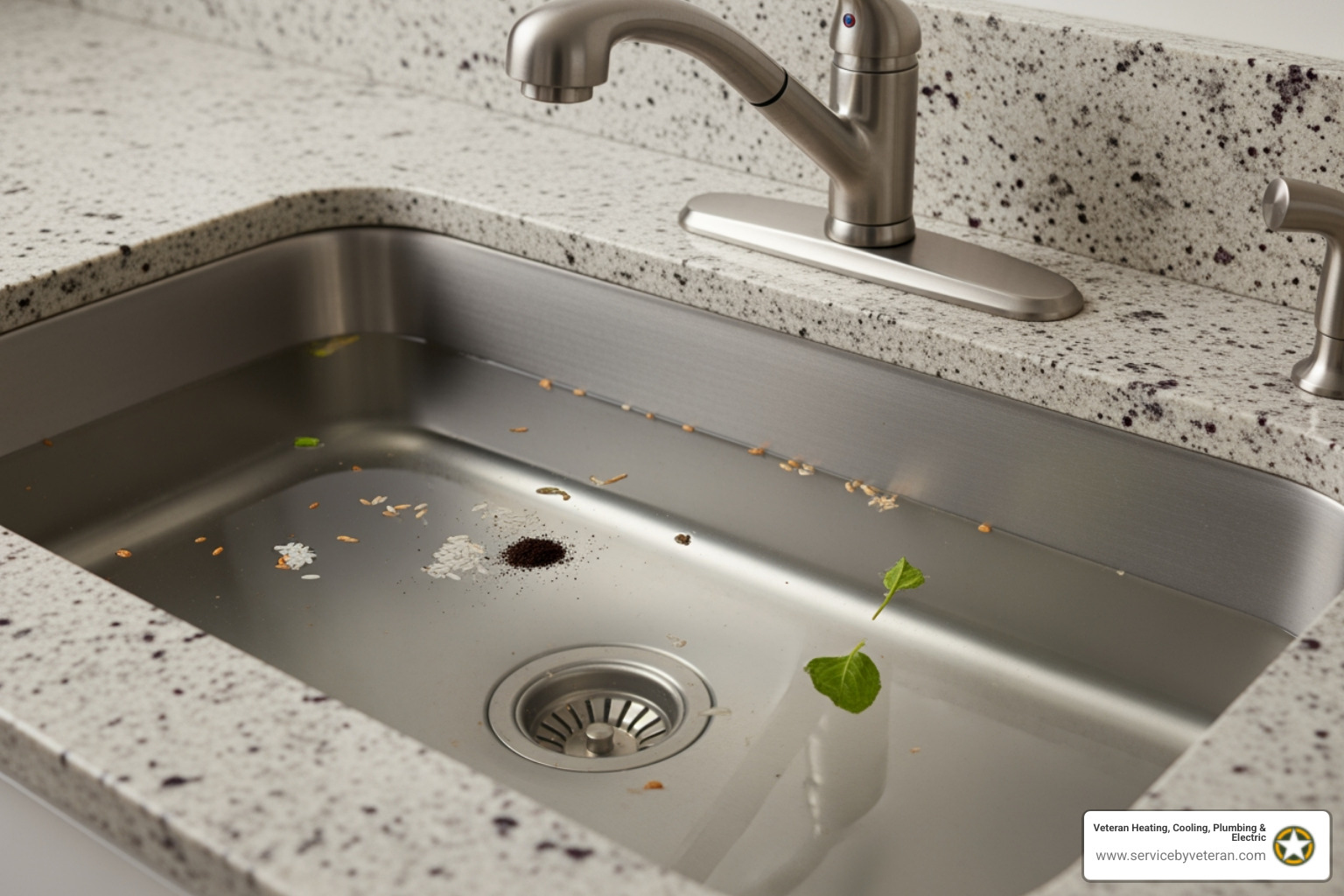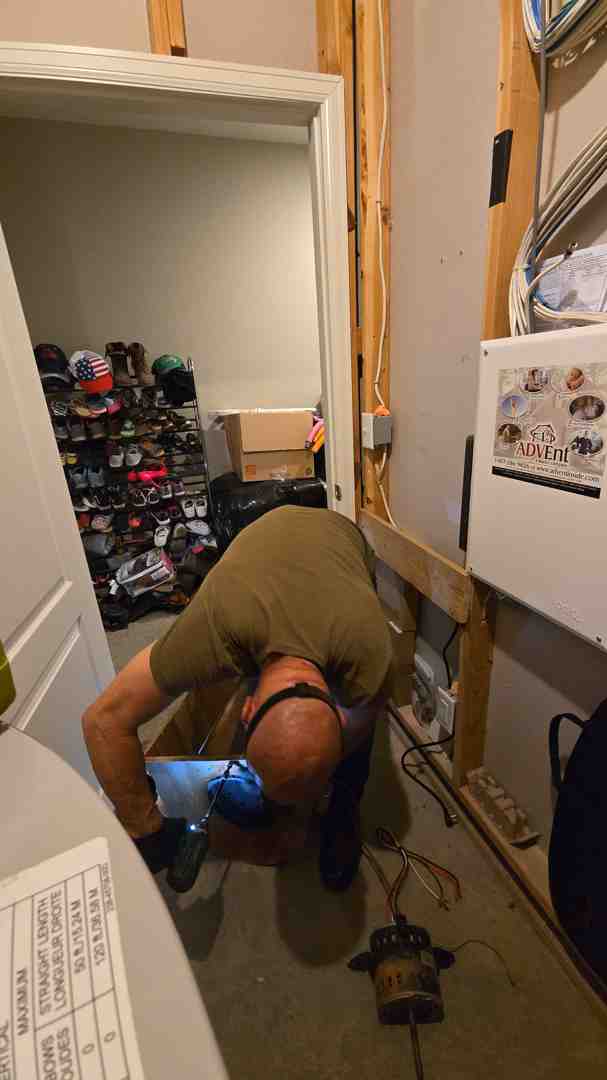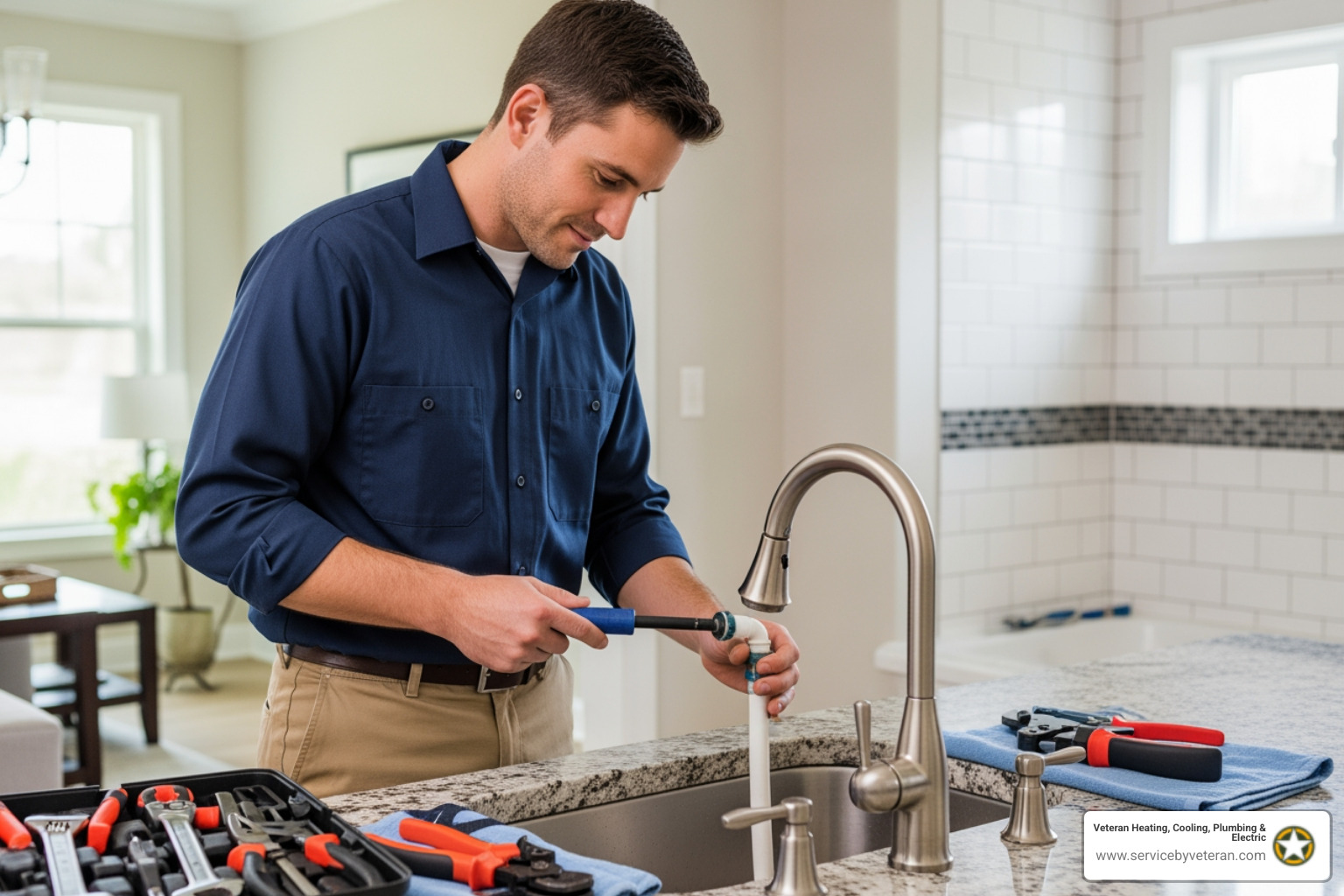Why Sewer Line Cleaning Protects Your Home
Sewer line cleaning removes blockages, debris, and buildup from the main pipe that carries wastewater from your home to the municipal sewer system or septic tank.
Key Facts About Sewer Line Cleaning:
- Cost: $196-$289 on average nationally
- Methods: Snaking ($100-$200) or hydro jetting ($350-$600)
- Frequency: Every 18-22 months for newer homes, annually for homes over 40 years old
- Signs you need it: Multiple slow drains, gurgling sounds, sewage backup, foul odors
Your home's drain pipes are the secondary lines from sinks, showers, and toilets that feed into your main sewer line—the single, larger pipe carrying all wastewater from your property.
When the main line clogs, wastewater backs up to the lowest drain in your house, often a basement floor drain. This is a health hazard that can cause thousands of dollars in property damage.
Regular cleaning prevents these costly emergencies. Homes with tree root problems or pipes with "bellies" (low spots that trap debris) may need cleaning every 12-18 months to avoid backups.
I'm Mike Townsend. My military experience taught me that proactive maintenance prevents system failures—a principle that applies directly to sewer line cleaning. As a veteran-owned service provider, I've seen how regular maintenance saves homeowners from emergency repairs and protects their most valuable investment.
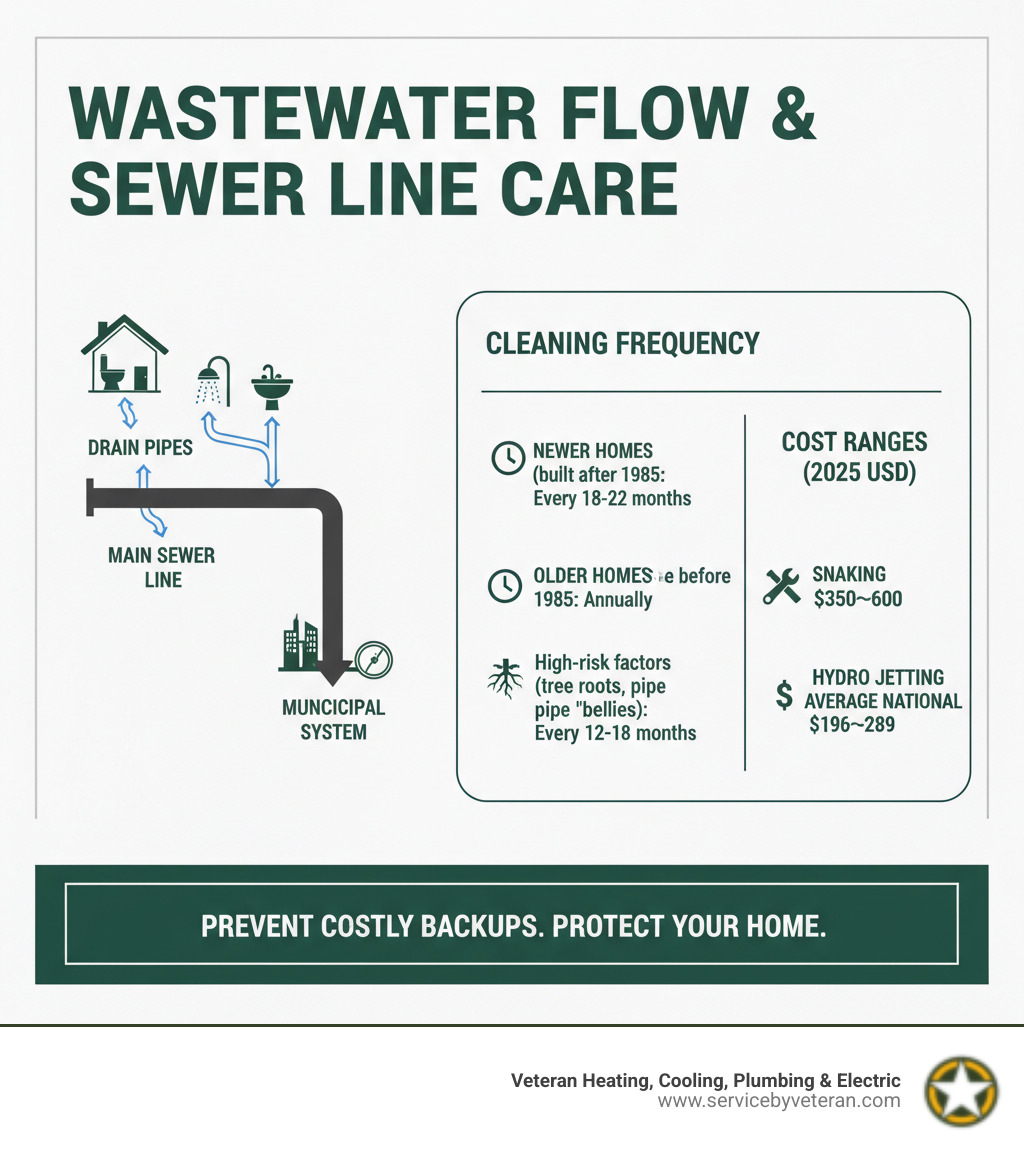
Signs Your Sewer Line Needs Cleaning
Recognizing the warning signs of a sewer line issue can save you from a major plumbing nightmare. Some hints are subtle, while others are impossible to ignore.
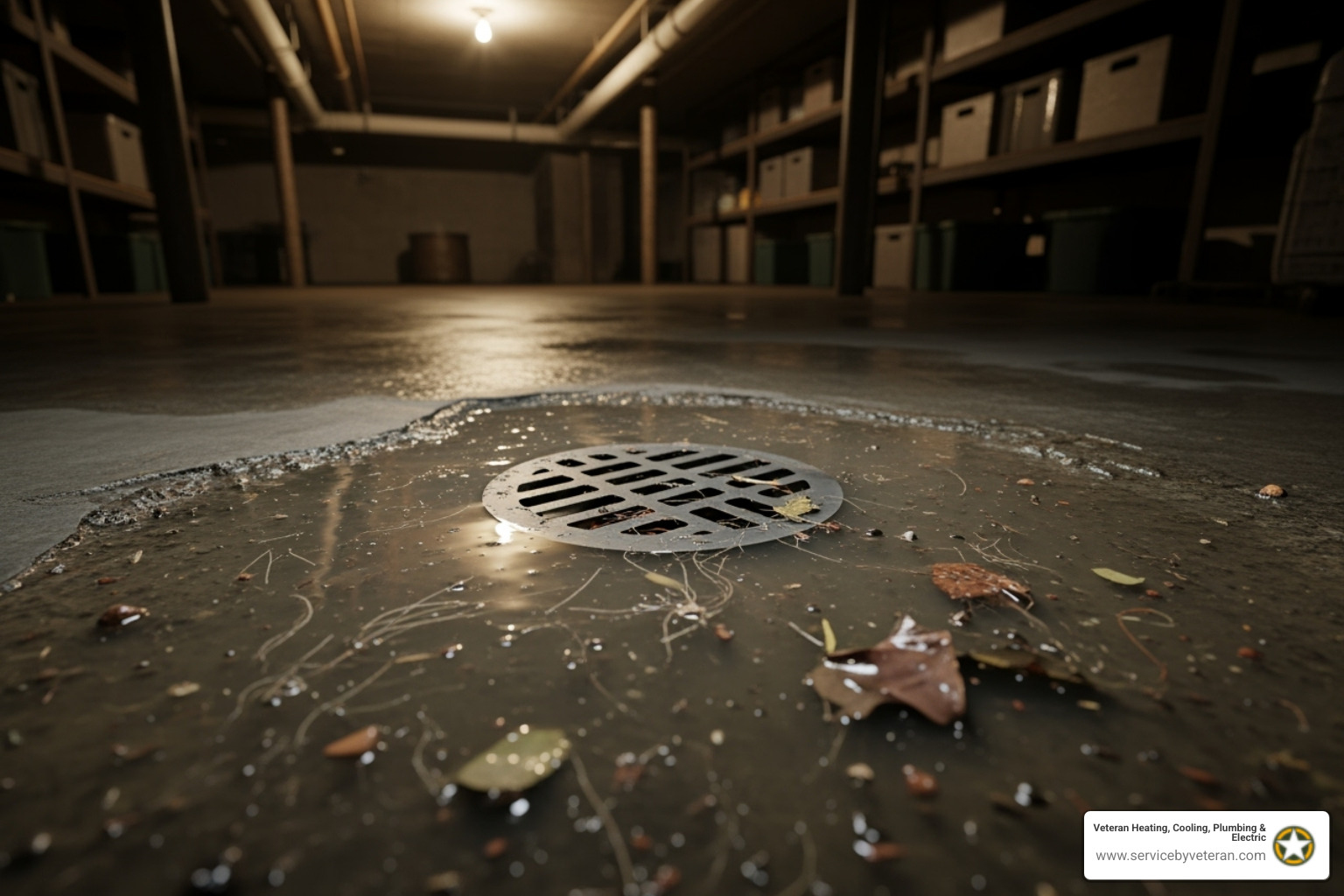
Watch for slow drains throughout your home. While one sluggish drain might be a local clog, multiple slow drains at once point to a main sewer line problem. Multiple clogged fixtures, like a toilet that won't flush while the tub backs up, confirm a main line issue that needs professional sewer line cleaning.
Listen for gurgling sounds from your drains. This is the sound of trapped air fighting to escape past a blockage in your sewer line.
Foul odors are another unpleasant sign. That rotten egg smell is sewer gas, a byproduct of decomposing waste. If you smell it near your drains or on your property, your sewer line needs help.
The most obvious sign is sewage backup. This occurs when the sewer line is completely blocked, sending wastewater back into your home through the lowest drain, usually in the basement. Also, check your yard for unusual water pooling, which could indicate a leak from a broken or severely blocked pipe.
Top 5 Warning Signs of a Sewer Clog:
- Multiple slow drains throughout the house
- Gurgling sounds from drains after flushing
- Sewage backup in basement or lowest drains
- Persistent sewer gas odors from drains
- Water pooling in yard near sewer line
Understanding the Symptoms
Certain symptoms clearly indicate a main line blockage. For instance, if water backs up in your shower when you flush the toilet, it's because the water has nowhere else to go. Similarly, if your toilet water level changes randomly, it signals pressure imbalances from a downstream clog. Strange drain noises like bubbling or sucking also point to an obstruction.
When to Take Immediate Action
Some signs require an emergency call. If you have sewage in your bathtub or basement, your main line is completely blocked. When all drains are backing up simultaneously, it's a system-wide failure. A strong sewer gas odor throughout your home is also an emergency, as it can be hazardous. These situations require immediate professional sewer line cleaning.
Professional Sewer Line Cleaning Methods Explained
When your sewer line is clogged, our professional technicians will solve the problem completely. We use two primary methods for sewer line cleaning: snaking and hydro jetting. After assessing your situation, we recommend the best approach to get your pipes flowing freely again. The choice depends on the cause of the blockage, from simple debris to stubborn tree roots.
Hydro Jetting: The High-Pressure Solution
Hydro jetting is like power washing your pipes from the inside. It's a highly effective method for removing years of buildup.
How hydro jetting works: We insert a hose with a specialized nozzle into your sewer line. This hose blasts high-pressure water streams (over 4,000 PSI) to cut through any blockage. Forward-facing jets break up obstructions, while rear-facing jets scour the pipe walls, blasting away grease, mineral scale, and tree roots.
Hydro jetting is exceptionally thorough. Instead of just punching a hole through a clog, it involves removing grease, scale, and roots completely, restoring your pipes to nearly their original diameter. This makes it an excellent long-term solution for chronic backup problems.

For more details about our comprehensive plumbing solutions and advanced cleaning techniques, check out More info about our plumbing services.
Snaking (Rodding): The Traditional Approach
Snaking is a tried-and-true method for clearing many types of sewer line clogs.
How snaking works: We use a professional drain snake, which is a flexible cable with a cutting head. This auger or drain snake is fed into the sewer line, where it spins to push through or break up the blockage.
Snaking excels at breaking up solid obstructions. It's particularly effective and cost-efficient for hair clogs, foreign objects, and minor root intrusions. It's often the best for simple clogs that need to be cleared quickly.
However, snaking is less effective for grease or scale buildup that coats the pipe walls. It clears a path but doesn't clean the entire pipe interior like hydro jetting does.
Our experienced technicians will determine which method is best for your situation and budget.
Cost, Frequency, and Prevention
Homeowners need straight answers about the timing and budget for sewer line cleaning. We believe in transparent pricing and helping you plan for this essential maintenance. Regular cleaning is far less expensive than emergency repairs and the potential property damage from a backup.
How Often Should You Clean Your Sewer Line?
The ideal frequency for sewer line cleaning varies, but here are some solid guidelines for homes in the Denver, Boulder, and Fort Collins areas.
- Newer Homes (under 40 years old): Proactive cleaning every 18-22 months is usually sufficient to prevent major buildup.
- Older Homes (over 40 years old): Plan on annual cleaning. Older pipes are more prone to corrosion, bellies (low spots), and root infiltration.
- Homes with Tree Roots: If you have mature trees near your sewer line, clean it every 12-18 months. Roots are a persistent problem.
- Small Households: Surprisingly, homes with fewer people and low-flow fixtures may need cleaning every 12-18 months. Less water flow means debris isn't flushed as effectively.
Our maintenance plans can create a custom schedule for your home, taking the guesswork out of it.
The Cost of Professional Sewer Line Cleaning
Professional sewer line cleaning typically costs $196-$289 nationally, but the method used is a major factor.
- Snaking costs $100-$200 and is effective for simple, solid clogs.
- Hydro jetting runs $350-$600 and provides a complete cleaning that lasts longer, making it a better value for preventing recurring issues.
Other factors influencing cost include the accessibility of your sewer cleanout, the clog severity, and its location within your system. A camera inspection may be recommended for recurring problems, which adds to the initial cost but can save money by ensuring the correct solution is applied. Our financing options can help manage this investment.
How to Prevent Future Clogs
Small changes in your daily habits can significantly reduce the need for frequent sewer line cleaning.
- Never pour grease down the drain. Scrape cooking oil and fat into the trash.
- Do not flush "flushable" wipes. They don't break down like toilet paper and are a primary cause of clogs. Only flush human waste and toilet paper.
- Use drain strainers in sinks and showers to catch hair and food particles.
- Be mindful of what goes down any drain. Avoid flushing coffee grounds, dental floss, cotton swabs, and paper towels.
The best prevention is a regular maintenance schedule. Our plans keep your system running smoothly and help catch issues before they become emergencies.
Beyond Cleaning: Inspections, Repairs, and Common Culprits
Sometimes, sewer line cleaning isn't enough. Recurring clogs often indicate a deeper problem, like invasive tree roots or damaged pipes. Our team is equipped to diagnose and fix these complex issues across our Colorado service areas.
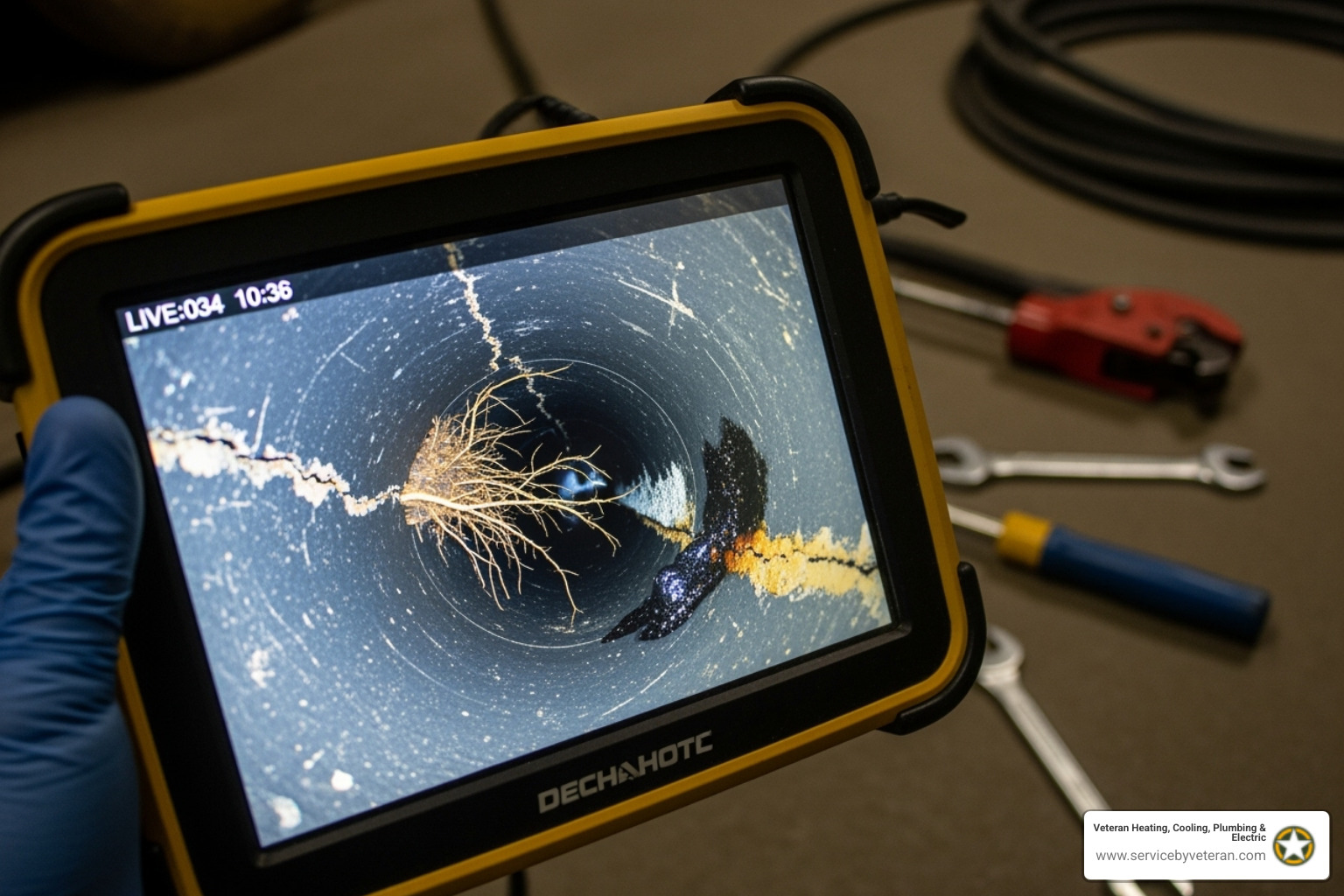
The Role of a Sewer Camera Inspection
A sewer camera inspection provides a live video feed from inside your pipes, eliminating guesswork. We recommend an inspection in several situations:
- Post-cleaning verification: To ensure a blockage is completely cleared.
- Pre-purchase inspection: To uncover hidden sewer problems before buying a home.
- Diagnosing recurring clogs: To pinpoint the exact cause, such as roots or a sagging pipe.
- Locating damage for targeted repairs: To find the precise location of a crack or break, saving time and money on excavation.
Common Culprits: Tree Roots and 'Flushable' Wipes
Two culprits are responsible for most sewer line problems: tree roots and "flushable" wipes.
Tree roots seek water and can invade sewer lines through the smallest cracks. They grow into dense masses that trap waste, cause blockages, and can eventually crack or collapse pipes. Minor roots can be cut with a snake, but heavy invasions often require hydro jetting. If the pipe is damaged, repair or replacement may be necessary.
"Flushable" wipes are not flushable. Unlike toilet paper, they contain durable fibers that do not break down in water. They snag on imperfections in pipes, collect grease, and form massive blockogs known as "fatbergs." Only human waste and toilet paper should ever be flushed.
For more answers, see our Frequently Asked Questions on Sewer Lines.
Locating Your Sewer Cleanout and When to Repair
Your sewer cleanout is the capped access point that makes professional sewer line cleaning possible. It's typically a 4-inch pipe with a cap located outside, a few feet from your foundation. In some homes, it may be in the basement or crawl space. An accessible cleanout makes service faster and less expensive.
Sometimes, cleaning isn't enough and a repair is needed. Signs that you may need a repair include:
- Recurring clogs in the same spot: This suggests an underlying structural issue.
- Cracked or broken pipes: Caused by shifting soil, roots, or age.
- Offset joints: Where pipe sections no longer align, creating a lip that catches debris.
- Bellied pipes: Sunken sections where waste and water collect.
- Persistent leaks or soggy spots in your yard: A clear sign of a broken line.
If our inspection reveals significant damage, we will explain the best repair options. Contact Us for a thorough assessment.
Frequently Asked Questions about Sewer Line Maintenance
We've answered thousands of questions from homeowners across Colorado. Here are some of the most common ones, with straight-talk answers.
What's the difference between a drain pipe and a sewer line?
Think of your plumbing like a tree. Drain pipes are the small branches from individual fixtures like sinks and showers. They all connect to the main sewer line, which is the large trunk that carries all wastewater from your house to the municipal sewer or septic system. A clog in one drain is a local issue; clogs in multiple fixtures point to a main sewer line problem.
Are DIY sewer line cleaning methods effective?
For a single clogged sink, DIY methods can sometimes offer a temporary fix. However, for your main sewer line, we strongly advise against DIY attempts. Main line blockages are deeper and more complex, requiring professional-grade equipment. Chemical drain cleaners can corrode older pipes, and consumer-grade snakes can damage your plumbing or worsen the clog.
What are the consequences of not cleaning a sewer line?
Ignoring a clogged sewer line can lead to serious consequences:
- Sewage backup: Raw sewage can flood your home, causing thousands in property damage.
- Health hazards: Wastewater contains harmful bacteria and pathogens.
- Expensive emergency repairs: A complete blockage often happens at the worst time and costs more to fix than scheduled maintenance.
- Long-term pipe damage: Pressure from a blockage can crack, leak, or even collapse your pipes, requiring major excavation and replacement.
Preventative sewer line cleaning is a small investment that avoids these major disasters.
Conclusion
Your home's sewer line cleaning doesn't have to be a source of stress. By recognizing early warning signs and understanding the professional solutions available, you can keep your pipes flowing freely.
The most important takeaway is that proactive maintenance beats emergency repairs every time. Scheduling regular cleaning every 18-22 months (or more often for older homes) protects your property and your family's health. The cost of professional cleaning, averaging $196-$289, is minor compared to the thousands you could spend on damage from a sewage backup.
As a veteran-owned business serving Denver, Fort Collins, Boulder, and nearby communities, we value doing things right. My military background taught me that preventative maintenance is essential for keeping critical systems running. We bring that same dedication to every service call. Our lifetime warranty and money-back guarantee reflect our commitment to your satisfaction.
Ready to protect your home? For expert sewer line cleaning and all your home service needs, explore Our Services. Let's work together to keep your plumbing system running smoothly.

